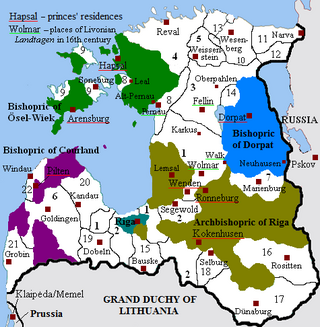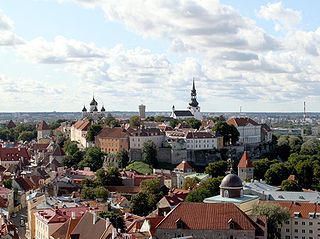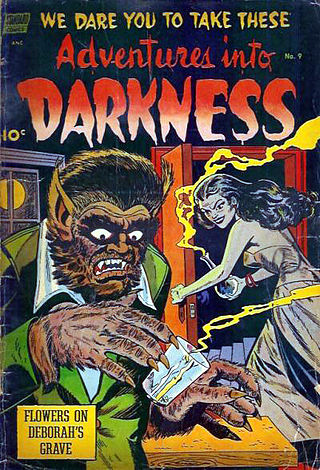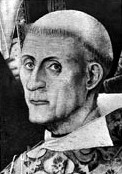
The Hanseatic League was a medieval commercial and defensive confederation of merchant guilds and market towns in Central and Northern Europe. Growing from a few North German towns in the late 12th century, the League expanded between the 13th and 15th centuries and ultimately encompassed nearly 200 settlements across seven modern-day countries, ranging from Estonia in the north and east, to the Netherlands in the west, and Kraków, Poland, in the south.

Jan Hus, sometimes anglicized as John Hus or John Huss, and referred to in historical texts as Iohannes Hus or Johannes Huss, was a Czech theologian and philosopher who became a Church reformer and the inspiration of Hussitism, a key predecessor to Protestantism, and a seminal figure in the Bohemian Reformation. Hus is considered by some to be the first Church reformer, even though some designate the theorist John Wycliffe. His teachings had a strong influence, most immediately in the approval of a reformed Bohemian religious denomination and, over a century later, on Martin Luther.

Lübeck ; officially the Hanseatic City of Lübeck, is a city in Northern Germany. With around 220,000 inhabitants, it is the second-largest city on the German Baltic coast and the second-largest city in the state of Schleswig-Holstein, after its capital of Kiel, and is the 36th-largest city in Germany.

Livonia or in earlier records Livland, is a historical region on the eastern shores of the Baltic Sea. It is named after the Livonians, who lived on the shores of present-day Latvia.

Year 1227 (MCCXXVII) was a common year starting on Friday of the Julian calendar.

Magdeburg rights were a set of town privileges first developed by Otto I, Holy Roman Emperor (936–973) and based on the Flemish Law, which regulated the degree of internal autonomy within cities and villages granted by the local ruler. Named after the German city of Magdeburg, these town charters were perhaps the most important set of medieval laws in Central Europe. They became the basis for the German town laws developed during many centuries in the Holy Roman Empire. The Magdeburg rights were adopted and adapted by numerous monarchs, including the rulers of Bohemia, Hungary, Poland and Lithuania, a milestone in the urbanization of the region which prompted the development of thousands of villages and cities.

Canute VI was King of Denmark (1182–1202). Contemporary sources describe Canute as an earnest, strongly religious man.

Toompea is a limestone hill in the central part of the city of Tallinn, the capital of Estonia. The hill is an oblong tableland, which measures about 400 by 250 metres, has an area of 7 hectares and is about 20–30 metres higher than the surrounding areas. In folklore the hill is known as the tumulus mound over the grave of Kalev, erected in his memory by his grieving wife.

Werewolf fiction denotes the portrayal of werewolves and other shapeshifting therianthropes, in the media of literature, drama, film, games and music. Werewolf literature includes folklore, legend, saga, fairy tales, Gothic and horror fiction, fantasy fiction and poetry. Such stories may be supernatural, symbolic or allegorical. A classic cinematic example of the theme is The Wolf Man (1941) which in later films joins with the Frankenstein Monster and Count Dracula as one of the three famous icons of modern day horror. However, werewolf fiction is an exceptionally diverse genre, with ancient folkloric roots and manifold modern re-interpretations.
The Aarne–Thompson–Uther Index is a catalogue of folktale types used in folklore studies. The ATU Index is the product of a series of revisions and expansions by an international group of scholars: originally composed in German by Finnish folklorist Antti Aarne (1910), the index was translated into English, revised, and expanded by American folklorist Stith Thompson, and later further revised and expanded by German folklorist Hans-Jörg Uther (2004). The ATU Index, along with Thompson's Motif-Index of Folk-Literature (1932)—with which it is used in tandem—is an essential tool for folklorists.

The Duchy of Estonia, also known as Danish Estonia, was a direct dominion of the King of Denmark from 1219 until 1346 when it was sold to the Teutonic Order and became part of the Ordensstaat.

Bernt Notke was a late Gothic artist from the Baltic region. He has been described as one of the foremost artists of his time in northern Europe.

The Free and Hanseatic City of Lübeck was a city-state from 1226 to 1937, in what is now the German states of Schleswig-Holstein and Mecklenburg-Vorpommern.
"The Ass", "The Donkey", or "The Little Donkey" is a German fairy tale collected by Brothers Grimm compiled in the Grimm's Fairy Tales.

Rubén Plaza Molina is a Spanish former professional road bicycle racer, who competed professionally between 2001 and 2019 for the Comunidad Valenciana–Kelme, Benfica, Liberty Seguros, Movistar Team, Lampre–Merida, Orica–Scott and Israel Cycling Academy teams. During his career, he recorded a top 5 overall placing in the 2005 Vuelta a España, and won three Grand Tour stages.

Grateful dead is both a motif and a group of related folktales present in many cultures throughout the world.

Michael Sittow, also known as Master Michiel, Michel Sittow, Michiel, Miguel, and several other variants, was a painter from Reval (Tallinn), Estonia who was trained in the tradition of Early Netherlandish painting. For most of his life, Sittow worked as a court portrait painter, for Isabella of Castile and her Habsburg relatives in Spain and the Netherlands, and other prominent royal houses. He is considered one of the most important Netherlandish painters of the era.
August Mälk was an Estonian writer and politician.

Kaarma-Kirikuküla is a village in Saaremaa Parish, Saare County in western Estonia. As of 2011 Census, the settlement's population was 18.

Walther Schröder was a German Nazi Party politician, SS-Brigadeführer and Police President of Lübeck, who served as an SS and Police Leader in Latvia and Estonia during the Second World War.

















